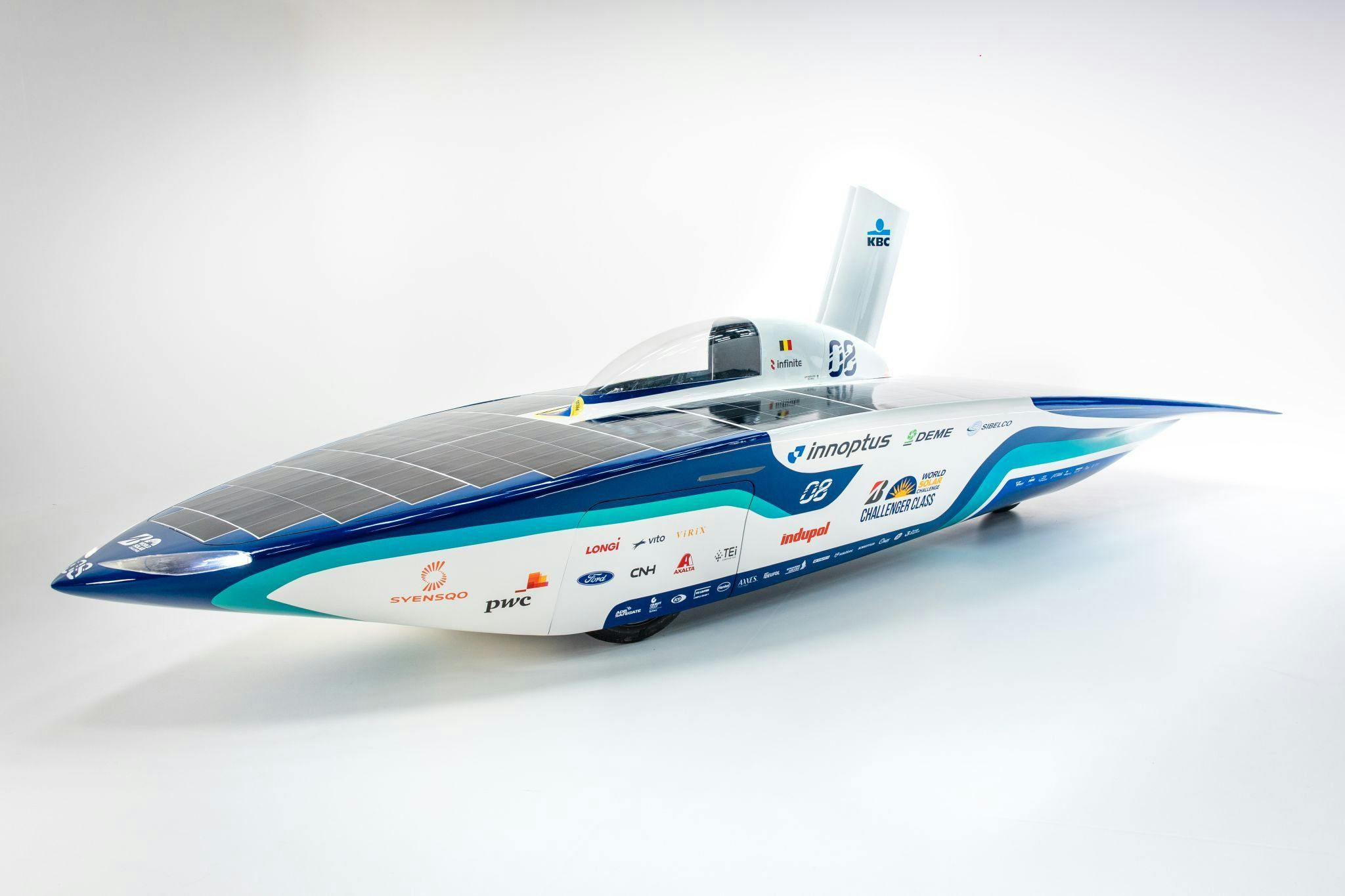Is this our next world champion? Belgian Solar Team unveils new solar car for World Championship in Australian winter
Monday 5 May 2025 - With a larger and more efficient solar panel, innovative double fins and a smaller battery, Infinite Apollo, the latest Belgian solar car, is not only built to defend the world title in Australia. It also serves as a realistic test platform for the technology of the future. The car was presented today at the Handelsbeurs in Antwerp by the Innoptus Solar Team, a group of engineering students from KU Leuven. It was designed for the World Cup, which will exceptionally take place during the Australian winter this year.
"The importance of this project for the future of our society lies in youth, expertise and progress — three elements that go hand in hand."
Jean-Luc Crucke, Minister of Climate, Mobility and Ecological Transition
Pushing the boundaries in solar innovation
The team wants to make a difference with a striking innovation: two parallel aerodynamic fins, a world first. Where the previous solar car used one rotating fin, the team now opts for a fixed system with two fins. They are integrated behind the cockpit and can be deployed when necessary. This ensures significantly more stability in crosswinds and allows the car to "sail" on the wind in changing conditions, which benefits speed, stability, and energy efficiency.

In addition, the team worked with LONGi, a market leader in solar cell technology, to develop a new solar panel with a surface area of 6 m² and an efficiency of more than 27%. This technology, soon to be commercially available, shows that the Infinite Apollo is not only a technological showpiece but also a realistic test platform for the industry.
Despite the 50% larger solar panel, the car's weight was limited to 170 kg. Due to new regulations, the battery capacity was reduced to 3 kWh, just a third of its predecessor's. Still, the car travels more than 300 kilometers using solar energy. For comparison, a Tesla Model 3 only travels 22 kilometers with the same amount of energy.
“Because we have two fins, we can choose which one to use, depending on the circumstances. Because they are also adjustable in height, we gain flexibility and efficiency.”
Julie Ter Hark (23, Brasschaat), Aerodynamic engineer at the Innoptus Solar Team
“We built the solar panel together with LONGi, not only for our own efficient solar panel, but also as an example of how technology from the lab can become reality. What will soon be on the market, we are testing today in extreme conditions.”
Maarten Vansteenkiste (23, Tervuren), High voltage at the Innoptus Solar Team
A winter race full of challenges
For the first time, the Bridgestone World Solar Challenge will be held during the Australian winter. Lower temperatures and less sunlight make the conditions tougher than ever. The race covers 3,021 kilometers, from Darwin to Adelaide, and starts on 24 August, two months earlier than usual, which gives a lot less time to develop the car.
"As the main sponsor, we strongly believe in the power of innovation. With the Infinite Apollo, the Innoptus Solar Team has shown how they have been able to create a completely new concept from start to finish. And that is fantastic.''
Marc Lambricks, Managing Director of Infinite Simulation Systems, main partner of the Innoptus Solar Team
Defending a World Title
After victories in 2019 and 2023, the team returns to Australia with one goal: to win a third consecutive world title. The competition brings together the best student teams worldwide, including the Netherlands, Germany, Japan, and the United States.
With the new regulations, all teams face the same challenges. The result? A level playing field — and a particularly exciting race. Every energy-saving strategy, every gram saved, every efficiently used watt can make the difference in who arrives first in Adelaide.
“Because the race was brought forward by two months, we actually had to develop a completely new solar car in record time. That pressure forced us to be more creative than ever — and that has led to technological innovations that allow us to perform in the Australian winter as well.”
Wout Rubbrecht (23, Vosselaar), Team Manager of the Innoptus Solar Team


About the Bridgestone World Solar Challenge
The Bridgestone World Solar Challenge occurs every two years and runs 3,021 kilometers across the Australian outback, from Darwin to Adelaide. The 2025 edition starts on 24 August at 07:45 local time (00:15 Belgian time).
Before the race, each car undergoes a strict technical inspection and a qualification at the Australian race circuit, Hidden Valley Raceway, to determine the starting order.
Solar cars are only allowed to run on solar energy and are allowed on the track between 08:00 and 17:00 daily. Teams must set up camp along the road each evening.
The Innoptus Solar Team has participated in every edition since 2005 and builds an entirely new car for the race each time.
